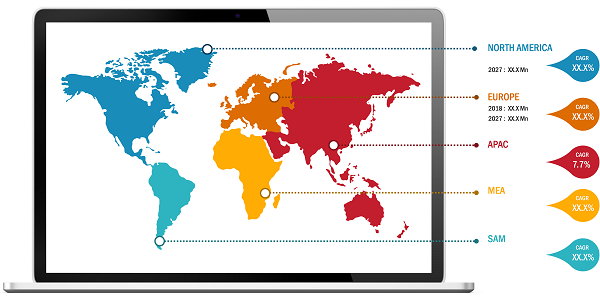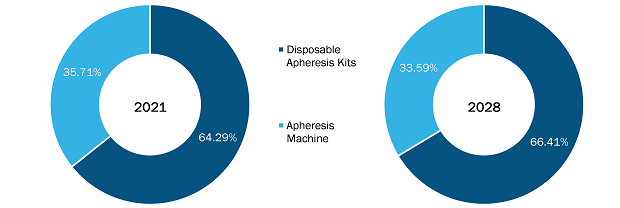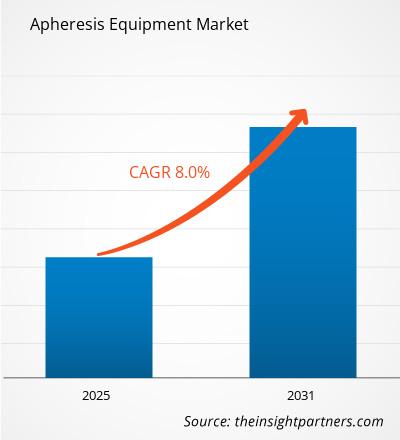Se espera que el mercado mundial de equipos de aféresis crezca desde 2.294,11 millones de dólares estadounidenses en 2021 a US$ 3.854,77 millones en 2031; se estima que crecerá con una tasa compuesta anual del 8,0% de 2022 a 2031.
La aféresis es un proceso en el que la sangre se extrae temporalmente del cuerpo del donante y se separa en varios componentes como plasma, plaquetas, glóbulos rojos y glóbulos blancos mediante centrifugación o separación por membrana, dependiendo de los componentes a separar. La aféresis elimina las impurezas y los componentes anormales de la sangre; por tanto, se prefiere para curar o controlar enfermedades. El mercado de equipos de aféresis se atribuye al creciente número de donantes de sangre voluntarios, la creciente incidencia de enfermedades hematológicas y la creciente población geriátrica. Sin embargo, factores como el alto costo del equipo de aféresis y las complicaciones asociadas con el procedimiento de aféresis están obstaculizando el crecimiento del mercado. Sin embargo, es probable que el creciente uso de la técnica de aféresis en las economías emergentes proporcione una oportunidad lucrativa para el crecimiento del mercado.
El mercado de equipos de aféresis está segmentado según el producto, la tecnología, el procedimiento, el área terapéutica, el usuario final y la geografía. El informe ofrece información y un análisis en profundidad del mercado de equipos de aféresis, enfatizando varios parámetros como las tendencias del mercado, los avances tecnológicos y la dinámica del mercado, así como el análisis del panorama competitivo de los principales actores del mercado.
Perspectivas estratégicas
regiones lucrativas del mercado de equipos de aféresis

El creciente número de donantes voluntarios de sangre impulsará el mercado de equipos de aféresis en los próximos años
La transfusión de sangre ayuda a salvar y mejorar la vida de las personas. Varios avances médicos mejoraron el tratamiento de enfermedades y lesiones graves y han aumentado la necesidad de transfusión de sangre para pacientes" supervivencia y mantenimiento de los pacientes’ salud. La conciencia sobre la importancia de las transfusiones de sangre en la atención sanitaria ha aumentado entre la población de todo el mundo, lo que ha provocado un aumento en el número de personas dispuestas a donar sangre con fines médicos. La Organización Mundial de la Salud (OMS) informa que en 2021 se recolectaron 117,4 millones de donaciones de sangre en todo el mundo. Además, los donantes de sangre generalmente se clasifican en voluntarios no remunerados, remunerados y familiares/de reemplazo. Las estimaciones de la OMS indicaron que se obtuvo un suministro confiable y adecuado de sangre de donantes voluntarios/no remunerados.
La tendencia de los donantes de sangre también es significativamente visible entre los países de ingresos bajos y medios. Por ejemplo, ha habido un aumento de 11,6 millones de donaciones de sangre de donantes voluntarios no remunerados entre 2008 y 2015 entre 139 países de todo el mundo, según la Organización Mundial de la Salud de 2021. Según los datos de la reunión anual del CAG en 2017, aproximadamente 13.000 procedimientos se realizaron en 1087 pacientes en 2016. El mayor aumento en el número de donantes voluntarios de sangre se ha encontrado en los países del Sudeste Asiático y Estados Unidos, es decir, 83 % y 70 %, respectivamente.
< p>Además, es probable que los programas nacionales de transfusión de sangre basados en el gobierno que se desarrollan y emplean en la mayoría de los países del mundo aumentar el número de donantes de plaquetas y sangre. Por ejemplo, en la India, el Consejo Nacional de Transfusión de Sangre (NBTC) se constituyó dentro de la Organización Nacional de Control del SIDA (NACO); de manera similar, se establecieron Consejos Estatales de Transfusión de Sangre (SBTC) dentro de las Sociedades Estatales de Control del SIDA (SACS). Por lo tanto, se espera que el creciente número de donantes elegibles en todo el mundo impulse la necesidad de equipos de aféresis que se utilizan principalmente para separar los componentes de la sangre necesarios para diversas necesidades médicas.Información basada en productos
Según el producto, el mercado mundial de equipos de aféresis se divide en kits de aféresis desechables y máquinas de aféresis. El segmento de kits de aféresis desechables tuvo una mayor participación del mercado en 2021, y también se prevé que registre una CAGR más alta en el mercado durante el período de pronóstico, debido al mayor uso de estos kits en procedimientos de aféresis.< /p>
Mercado de equipos de aféresis, por producto - 2021 y 2031

Información basada en tecnología
Basado en la tecnología, el mercado mundial de equipos de aféresis se divide en centrifugación y separación por membranas. En 2021, el segmento de separación de membranas tuvo una mayor participación de mercado y también se espera que crezca al ritmo más rápido durante los próximos años debido a la separación precisa de los componentes deseados de la solución de sangre completa.< /p>
Información basada en procedimientos
Según el procedimiento, el mercado mundial de equipos de aféresis se segmenta en plasmaféresis, fotoféresis, eritrocitaféresis, leucoféresis, plaquetoféresis, y aféresis de LDL. En 2021, el segmento de plasmaféresis ocupó la mayor cuota de mercado. Además, también se espera que el segmento de aféresis de LDL crezca al ritmo más rápido durante los próximos años.
Perspectivas basadas en áreas terapéuticas
Según el área terapéutica, el mercado mundial de equipos de aféresis se segmenta en hematología, enfermedades renales, neurología y otras áreas terapéuticas. En 2021, el segmento de hematología tuvo la mayor participación del mercado y también se espera que crezca al ritmo más rápido durante los próximos años.
Información basada en el usuario final
Según el usuario final, el mercado mundial de equipos de aféresis se segmenta en bancos de sangre/centros de donación de sangre, hospitales y hospitales. clínicas y centros quirúrgicos ambulatorios. En 2021, los hospitales & El segmento de clínicas tuvo la mayor participación del mercado y también se espera que crezca al CAGR más alto durante 2022 a 2031.
Según la geografía, el mercado mundial de equipos de aféresis está segmentado en América del Norte, Europa, Asia Pacífico, Medio Oriente y Asia. África y Sur & Centroamérica. El mercado mundial de equipos de aféresis de América del Norte tuvo la mayor participación del mercado en 2021. Estados Unidos dominó el mercado de equipos de aféresis de América del Norte. Se espera que el crecimiento del mercado en el país crezca al CAGR más alto debido a un número creciente de procedimientos de aféresis, junto con centros de aféresis, y un creciente acceso a una infraestructura sanitaria bien desarrollada.
< span style="font-family: verdana, geneva, sans-serif; font-size: 10pt;">Es probable que el mercado de equipos de aféresis de Canadá crezca debido al creciente número de procedimientos de intercambio de plasma y procedimientos de aféresis neurológica en todo el país. Además, es probable que el mercado de equipos de aféresis en México experimente oportunidades de crecimiento debido al aumento en el desarrollo del sistema de salud.
Por geografía, el mercado de equipos de aféresis está segmentado en América del Norte (EE. UU., Canadá y México), Europa (Reino Unido, Alemania, Francia, Italia, España y resto de Europa) , Asia Pacífico (China, Japón, India, Corea del Sur, Australia y resto de Asia Pacífico), Medio Oriente y Asia. África (Emiratos Árabes Unidos, Arabia Saudita, África y resto de Medio Oriente y África) y Sur y África. Centroamérica (Brasil, Argentina y resto de Centro y Suramérica).
Perfiles de empresas
El El mercado de equipos de aféresis está formado principalmente por jugadores como Medica SPA; Corporación Terumo; B. Braun Melsungen AG; Fresenius Medical Care AG & Co. KGaA; Corporación Asahi Kasei; Corporación Haemonetics; Corporación HemaCare; CORPORACIÓN KANEKA MEDIX; Laboratorios Kawasumi, Inc.; y medicap clinic GmbH, entre otros.
- Análisis histórico (2 años), año base, pronóstico (7 años) con CAGR
- Análisis PEST y FODA
- Tamaño del mercado Valor/volumen: global, regional, nacional
- Industria y panorama competitivo
- Conjunto de datos de Excel
- Military Rubber Tracks Market
- Aircraft Landing Gear Market
- Aesthetic Medical Devices Market
- Small Internal Combustion Engine Market
- Cosmetic Bioactive Ingredients Market
- Water Pipeline Leak Detection System Market
- Smart Parking Market
- Embolization Devices Market
- Constipation Treatment Market
- Integrated Platform Management System Market

Report Coverage
Revenue forecast, Company Analysis, Industry landscape, Growth factors, and Trends

Segment Covered
This text is related
to segments covered.

Regional Scope
North America, Europe, Asia Pacific, Middle East & Africa, South & Central America

Country Scope
This text is related
to country scope.
Preguntas frecuentes
High price of apheresis instruments and complications related to apheresis are the main issues preventing the market growth.
The growth of the worldwide apheresis instrument market is ascribed to the rising range of voluntary blood donors, increasing incidence of hematological diseases and increasing geriatric population.
The apheresis instrumental separates blood elements by utilizing centrifugation or membrane separation, betting on the elements to be separated.
Apheresis is a method within which blood is temporarily removed from the donor’s body and separated into numerous elements like plasma, platelets, red blood cells further as white blood cells, by centrifugation or membrane separation process. The impurities and unusual elements within the blood are removed by the method of apheresis.
Trends and growth analysis reports related to Life Sciences : READ MORE..
The List of Companies
- Medica SPA
- Terumo Corporation
- B. Braun Melsungen AG
- Fresenius Medical Care AG & Co. KGaA
- Asahi Kasei Corporation
- Haemonetics Corporation,
- HemaCare Corporation
- Kaneka Medix Corporation
- Kawasumi Laboratories, Inc.
- Medicap Clinic GmbH
The Insight Partners performs research in 4 major stages: Data Collection & Secondary Research, Primary Research, Data Analysis and Data Triangulation & Final Review.
- Data Collection and Secondary Research:
As a market research and consulting firm operating from a decade, we have published and advised several client across the globe. First step for any study will start with an assessment of currently available data and insights from existing reports. Further, historical and current market information is collected from Investor Presentations, Annual Reports, SEC Filings, etc., and other information related to company’s performance and market positioning are gathered from Paid Databases (Factiva, Hoovers, and Reuters) and various other publications available in public domain.
Several associations trade associates, technical forums, institutes, societies and organization are accessed to gain technical as well as market related insights through their publications such as research papers, blogs and press releases related to the studies are referred to get cues about the market. Further, white papers, journals, magazines, and other news articles published in last 3 years are scrutinized and analyzed to understand the current market trends.
- Primary Research:
The primarily interview analysis comprise of data obtained from industry participants interview and answers to survey questions gathered by in-house primary team.
For primary research, interviews are conducted with industry experts/CEOs/Marketing Managers/VPs/Subject Matter Experts from both demand and supply side to get a 360-degree view of the market. The primary team conducts several interviews based on the complexity of the markets to understand the various market trends and dynamics which makes research more credible and precise.
A typical research interview fulfils the following functions:
- Provides first-hand information on the market size, market trends, growth trends, competitive landscape, and outlook
- Validates and strengthens in-house secondary research findings
- Develops the analysis team’s expertise and market understanding
Primary research involves email interactions and telephone interviews for each market, category, segment, and sub-segment across geographies. The participants who typically take part in such a process include, but are not limited to:
- Industry participants: VPs, business development managers, market intelligence managers and national sales managers
- Outside experts: Valuation experts, research analysts and key opinion leaders specializing in the electronics and semiconductor industry.
Below is the breakup of our primary respondents by company, designation, and region:

Once we receive the confirmation from primary research sources or primary respondents, we finalize the base year market estimation and forecast the data as per the macroeconomic and microeconomic factors assessed during data collection.
- Data Analysis:
Once data is validated through both secondary as well as primary respondents, we finalize the market estimations by hypothesis formulation and factor analysis at regional and country level.
- Macro-Economic Factor Analysis:
We analyse macroeconomic indicators such the gross domestic product (GDP), increase in the demand for goods and services across industries, technological advancement, regional economic growth, governmental policies, the influence of COVID-19, PEST analysis, and other aspects. This analysis aids in setting benchmarks for various nations/regions and approximating market splits. Additionally, the general trend of the aforementioned components aid in determining the market's development possibilities.
- Country Level Data:
Various factors that are especially aligned to the country are taken into account to determine the market size for a certain area and country, including the presence of vendors, such as headquarters and offices, the country's GDP, demand patterns, and industry growth. To comprehend the market dynamics for the nation, a number of growth variables, inhibitors, application areas, and current market trends are researched. The aforementioned elements aid in determining the country's overall market's growth potential.
- Company Profile:
The “Table of Contents” is formulated by listing and analyzing more than 25 - 30 companies operating in the market ecosystem across geographies. However, we profile only 10 companies as a standard practice in our syndicate reports. These 10 companies comprise leading, emerging, and regional players. Nonetheless, our analysis is not restricted to the 10 listed companies, we also analyze other companies present in the market to develop a holistic view and understand the prevailing trends. The “Company Profiles” section in the report covers key facts, business description, products & services, financial information, SWOT analysis, and key developments. The financial information presented is extracted from the annual reports and official documents of the publicly listed companies. Upon collecting the information for the sections of respective companies, we verify them via various primary sources and then compile the data in respective company profiles. The company level information helps us in deriving the base number as well as in forecasting the market size.
- Developing Base Number:
Aggregation of sales statistics (2020-2022) and macro-economic factor, and other secondary and primary research insights are utilized to arrive at base number and related market shares for 2022. The data gaps are identified in this step and relevant market data is analyzed, collected from paid primary interviews or databases. On finalizing the base year market size, forecasts are developed on the basis of macro-economic, industry and market growth factors and company level analysis.
- Data Triangulation and Final Review:
The market findings and base year market size calculations are validated from supply as well as demand side. Demand side validations are based on macro-economic factor analysis and benchmarks for respective regions and countries. In case of supply side validations, revenues of major companies are estimated (in case not available) based on industry benchmark, approximate number of employees, product portfolio, and primary interviews revenues are gathered. Further revenue from target product/service segment is assessed to avoid overshooting of market statistics. In case of heavy deviations between supply and demand side values, all thes steps are repeated to achieve synchronization.
We follow an iterative model, wherein we share our research findings with Subject Matter Experts (SME’s) and Key Opinion Leaders (KOLs) until consensus view of the market is not formulated – this model negates any drastic deviation in the opinions of experts. Only validated and universally acceptable research findings are quoted in our reports.
We have important check points that we use to validate our research findings – which we call – data triangulation, where we validate the information, we generate from secondary sources with primary interviews and then we re-validate with our internal data bases and Subject matter experts. This comprehensive model enables us to deliver high quality, reliable data in shortest possible time.



 Get Free Sample For
Get Free Sample For